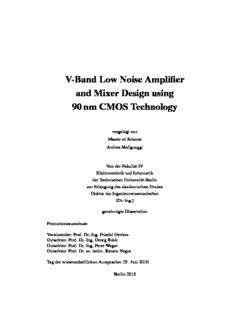
V-Band Low Noise Amplifier and Mixer Design using 90 nm CMOS Technology PDF
Preview V-Band Low Noise Amplifier and Mixer Design using 90 nm CMOS Technology
V-Band Low Noise Amplifier and Mixer Design using 90 nm CMOS Technology vorgelegtvon MasterofScience AndreaMalignaggi VonderFakulta¨tIV ElektrotechnikundInformatik derTechnischenUniversita¨tBerlin zurErlangungdesakademischenGrades DoktorderIngenieurwissenschaften (Dr.-Ing.) genehmigteDissertation Promotionsausschuss: Vorsitzender: Prof. Dr.-Ing. FriedelGerfers Gutachter: Prof. Dr.-Ing. GeorgBo¨ck Gutachter: Prof. Dr.-Ing. PeterWeger Gutachter: Prof. Dr. sc. techn. RenatoNegra TagderwissenschaftlichenAussprache: 23. Juni2016 Berlin2016 ii Acknowledgements Foremost,IwouldliketoexpressmysinceregratitudetomyadvisorProf. Georg Bo¨ck for the continuous support of my Ph.D study and research, for his patience, motivation, enthusiasm, and immense knowledge. His guidancehelpedmeinallthetimeofresearchandwritingofthisthesis. I am deeply grateful to all my collegues at MWT. I was lucky to meet suchpeople,whoadvicedandassistedmeduringmywork. I wish to express my love and gratitude to my family, for the under- standingandtheendlesslovethroughthedurationofmystudies. No,nontihodimenticato. Grazie... iii iv Abstract This thesis is the result of more than three years research work at TU- Berlin. Severalradiofrequencyintegratedcircuitshavebeendesignedina commercialCMOStechnology,theTSMC90nm,andmeasuredon-wafer within the project WiONet. The author of this work has been focused on the design of the receiver part of a V-band high data-rate millimetre-wave transceiverandparticularlyontwoimportantbuildingblockssuchaslow- noiseamplifieranddown-conversionmixer. At first, the specifications of the receiver and its sub-blocks have been extracted applying to the planned transceiver system the requirements ob- tained by the IEEE 802.15.3c standard. Afterwards, a deep study of the passive and active components provided by the technology and a careful characterizationofthestructurestobeusedhavebeencarriedoutinorder to get familiar with the technology and optimize its use. The noise be- haviourofseveralamplifierandmixertopologieshasbeendeeplystudied, leading to the design and the characterization of several CMOS circuits. Finally, a four stage fully differential common source low noise ampli- fier and a fully differential Gilbert cell with resonating current bleeding networkhavebeenchosenforbeingpartoftheWiONetsystem. Bothcir- cuits showed state of the art performance in terms of gain, linearity, noise andpowerconsumption. Furthermore,theyfulfilthesystemrequirements withinthewholeV-band. v vi Zusammenfassung Diese Dissertation ist das Ergebnis von mehr als drei Jahren Forschung an der TU Berlin. Mehrere integrierte Hochfrequenz-Schaltungen wurden innerhalb des Projekts WiONet in einer kommerziellen CMOS Technolo- gie, TSMC 90nm, entwickelt und gemessen. Ziel des Projektes war die Entwicklung eines V-Band Transceivers im Millimiterwellenbereich fu¨r ku¨nftigeAnwendungenmitsehrhohenDatenu¨bertratungsraten.DerAutor dieserArbeithatsichaufdenEntwurfdesReceivers,insbesondereaufdie zwei wichtigen Elemente, rauscharmer Versta¨rker und Abwa¨rtsmischer, konzentriert. Die Spezifikationen des Receivers und dessen Untereinheiten wurden aus den geplanten Transceiver-Anforderungen entnommen, basierend auf dem IEEE 802.153c Standard. Anschließend wurden die von der Tech- nologie bereitgestellten passiven und aktiven Komponenten gru¨ndlich un- tersucht und eine gewissenhafte Charakterisierung der genutzten Struk- turen durchgefu¨hrt, um mit der Technologie vertraut zu werden und ih- ren Nutzen zu optimieren. Das Rauschverhalten mehrerer Versta¨rker- und Mischer-Architekturen, welche zu dem Design und der Charakterisierung verschiedener CMOS-Schaltungen fu¨hrte, wurde analysiert. Schlussend- lich wurde ein vier-stufiger volldifferenzieller, rauscharmer Versta¨rker in Source-Schaltung,sowieeinevolldifferenzielleGilbertZellemitresonan- temcurrentbleedingNetzwerkalsTeildesWiONetSystemsgewa¨hlt.Bei- de Schaltkreise entsprechen bezu¨glich Versta¨rkung, Linearita¨t, Rauschen und Leistungsaufnahme dem Stand der Technik. Außerdem genu¨gen sie denSystemanforderungenimkomplettenV-Band. vii viii Abbreviations TRx Transceiver IQ In-phaseandquadrature LNA Lownoiseamplifier CMOS Complementarymetal-oxide-semiconductor OOK On-offkeying IF Intermediatefrequency DC Directcurrent PLL Phasedlockedloop LO Localoscillator FTTH Fastfibretothehome FITH Fastfibreinthehome RF Radiofrequency IEEE InstituteofElectricalandElectronicsEngineers FSPL Freespaceloss PHY Physicallayer MAC Mediaaccesscontrol UM Usagemodel SC Singlecarrier HSI Highspeedinterface AV Audiovisual OFDM Orthogonalfrequencydivisionmultiplexing CMS Commonmodesignalling BPSK Binaryphaseshiftkeying QAM Quadratureamplitudemodulation QPSK Quadraturephaseshiftkeying DAMI dualalternatemarkinversion Tx Transmitter Rx Receiver BER Biterrorrate PAPR Peaktoaveragepowerratio F Noisefactor ix ABBREVIATIONS NF Noisefigure SNR Signaltonoiseratio IC Integratedcircuit BB Baseband DCM Downconversionmixer DEM Demodulator MOD Modulator UCM Upconversionmixer PA Poweramplifier SFD Staticfrequencydivider TSMC TaiwanSemiconductorManufacturingCompany f Transitionfrequency t f Maximumoscillationfrequency max UTM Ultrathickmetal GCTL Groundedcoplanartransmissionline DUT Deviceundertest GSG Ground-signal-ground MOS Metal-oxide-semiconductor BSIM BerkeleyShort-channelIGFETModel MSG Maximumstablegain EM Electro-magnetic SCTL Shieldedcoplanartransmissionline MIM Metal-insulator-metal CBM Capacitorbottommetal CTM Capacitortopmetal VCO Voltagecontrolledoscillator MAG Maximumavailablegain IP1dB Inputpoweratthe1dBcompressionpoint MOSFET Metal-oxide-semiconductorfield-effecttransistor P1dB 1dBcompressionpoint CMRR Commonmoderejectionratio P Directpower DC BW Bandwidth FOM Figureofmerit SSB Singlesideband DSB Doublesideband x
Description: